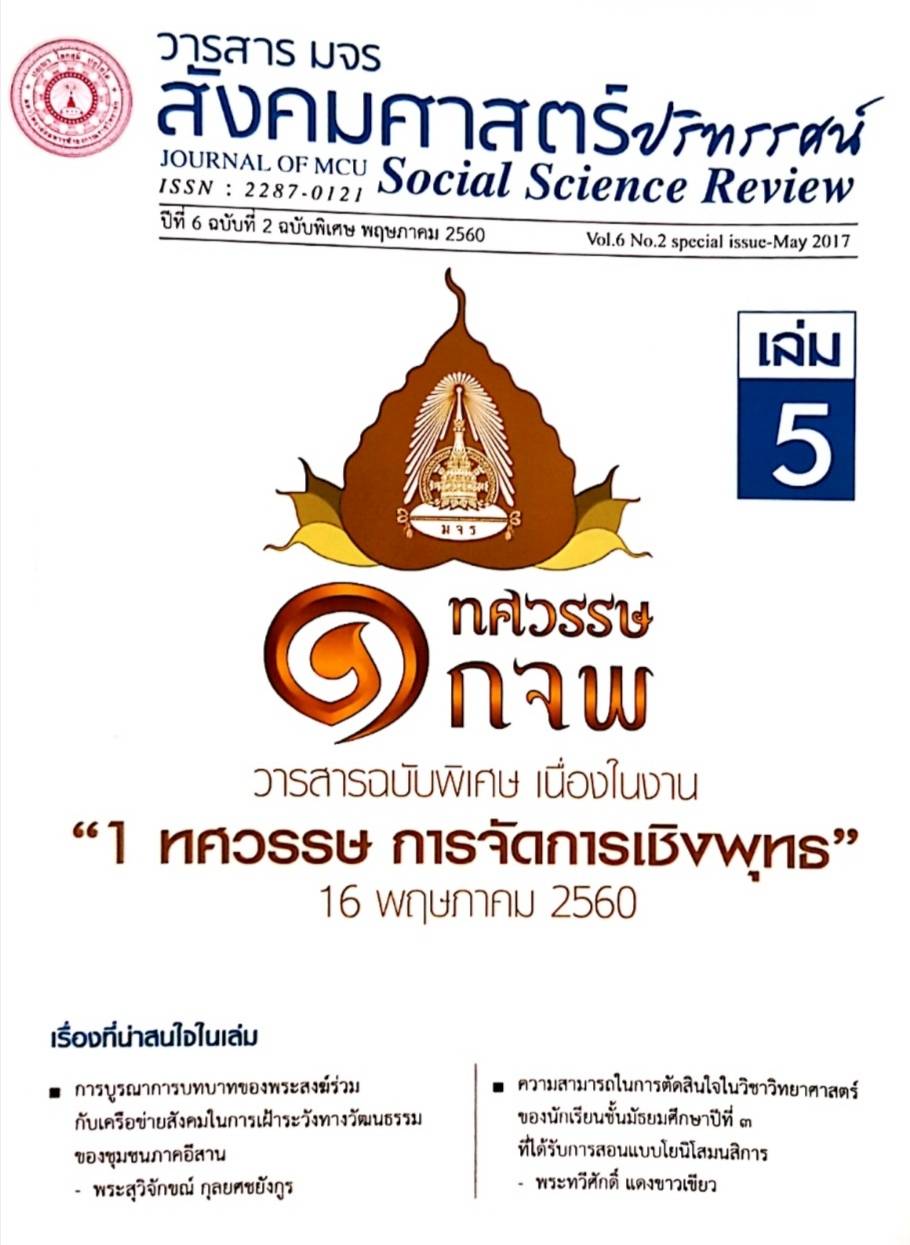ความสามารถในการตัดสินใจในวิชาวิทยาศาสตร์ของนักเรียน ชั้นมัธยมศึกษาปีที่ 3 ที่ได้รับการสอนแบบโยนิโสมนสิการ
คำสำคัญ:
ความสามารถในการตัดสินใจ; การสอนแบบโยนิโสมนสิการ; ผลสัมฤทธิ์ทางการเรียน; นักเรียนชั้นมัธยมศึกษาปีที่ 3บทคัดย่อ
บทความวิจัยนี้ มีวัตถุประสงค์เพื่อ (1) เพื่อศึกษาความสามารถในการตัดสินใจ ของนักเรียนระดับชั้นมัธยมศึกษาปีที่ 3 ที่ได้รับการสอนแบบโยนิโสมนสิการ (2) เพื่อศึกษาผลสัมฤทธิ์ทางการเรียนวิทยาศาสตร์ของนักเรียนระดับชั้นมัธยมศึกษาปีที่ 3 ที่ได้รับการสอนแบบโยนิโสมนสิการ ประชากรสำหรับการวิจัยในครั้งนี้ คือ นักเรียนชั้นมัธยมศึกษาปีที่ 3 โรงเรียนพระปริยัติธรรมพระเจ้าตนหลวง อำเภอบ้านโฮ่ง จังหวัดลำพูน ภาคเรียนที่ 2 ปีการศึกษา 2559 จำนวน 29 รูป เครื่องมือที่ใช้ในการวิจัยประกอบด้วย 1) แผนการจัดการเรียนรู้โดยใช้วิธีสอนแบบโยนิโสมนสิการ เรื่อง สิ่งแวดล้อมและทรัพยากรธรรมชาติ 2) แบบทดสอบวัดความสามารถในการตัดสินใจ เรื่อง สิ่งแวดล้อมและทรัพยากรธรรมชาติ 3) แบบวัดผลสัมฤทธิ์ทางการเรียน สำหรับนักเรียนชั้นมัธยมศึกษาปีที่ 3 หน่วยการเรียนรู้ เรื่อง สิ่งแวดล้อมและทรัพยากรธรรมชาติ สถิติที่ใช้ในการวิเคราะห์ข้อมูล ในการวิจัย ได้แก่ ค่าเฉลี่ย ค่าเฉลี่ยร้อยละ และส่วนเบี่ยงเบนมาตรฐาน ผลการวิจัยครั้งนี้พบว่า
- นักเรียนที่ได้รับการสอนแบบโยนิโสมนสิการ มีคะแนนเฉลี่ยความสามารถในการตัดสินใจในวิชาวิทยาศาสตร์หลังเรียนสูงกว่าก่อนเรียน
- นักเรียนที่ได้รับการสอนแบบโยนิโสมนสิการ มีคะแนนเฉลี่ยผลสัมฤทธิ์ทางการเรียน วิชาวิทยาศาสตร์ หน่วยการเรียนรู้ เรื่อง สิ่งแวดล้อมและทรัพยากรธรรมชาติ หลังเรียนสูงกว่าก่อนเรียน
เอกสารอ้างอิง
จิรวรรณ พงศ์สุวรรณสิน. (2542). “ผลการใช้ชุดฝึกการคิดตามหลักโยนิโสมนสิการที่มีต่อการ ตัดสินใจแก้ปัญหาของ นักเรียนชั้นประถมศึกษาปีที่ 6 โรงเรียนวัดท่ากฤษณา (สุชัย ประชาสรรค์) จังหวัดชัยนาท”. วิทยานิพนธ์ศึกษาศาสตรมหาบัณฑิต. บัณฑิตวิทยาลัย: มหาวิทยาลัยเชียงใหม่.
ทิศนา แขมมณี. (2556). ศาสตร์การสอน. พิมพ์ครั้งที่ 17. กรุงเทพฯ: สำนักพิมพ์แห่งจุฬาลงกรณ์ มหาวิทยาลัย.
พระธรรมปิฎก (ป.อ. ปยุตโต). (2543). การศึกษาเครื่องมือพัฒนาที่ยังต้องพัฒนา. กรุงเทพฯ: สหธรรมิก.
พระพรหมคุณาภรณ์ (ป.อ.ปยุตฺโต). (2555). พุทธธรรม ฉบับปรับขยาย : พุทธธรรม ประดิษฐาน 26 ศตวรรษกาล. กรุงเทพฯ : ผลิธัมม์.
ภพ เลาหไพบูลย์. (2542). แนวการสอนวิทยาศาสตร์. พิมพ์ครั้งที่ 3. กรุงเทพฯ: ไทยวัฒนาพานิช.
วนิช สุธารัตน์. (2547). ความคิดและความคิดสร้างสรรค์. กรุงเทพฯ: โอเดียนสโตร์.
วิศวเนตร เจริญสุข. (2552). “การพัฒนารูปแบบการจัดการเรียนรู้โดยใช้กิจกรรมฝึกคิดตามแนว โยนิโส มนสิการแบบคุณโทษและทางออกที่ส่งเสริมความสามารถในการตัดสินใจ ใน วิชาคณิตศาสตร์สำหรับนักเรียนชั้น มัธยมศึกษาปีที่ 3”. ปริญญาการศึกษา มหาบัณฑิต. บัณฑิตวิทยาลัย : มหาวิทยาลัยทักษิณ.
สายพิณ มีสุข. (2545). “ผลการสอนตามแนวโยนิโสมนสิการที่มีต่อความสามารถในการตัดสินใจและ ผลสัมฤทธิ์ทางการเรียนกลุ่มสร้างเสริมประสบการณ์ชีวิตของนักเรียนชั้นมัธยมศึกษา ปีที่ 6”. วิทยานิพนธ์ศึกษาศาสตรมหาบัณฑิต. บัณฑิตวิทยาลัย: มหาวิทยาลัยสงขลานครินทร์.
สำนักงานคณะกรรมการการศึกษาแห่งชาติ. (2544). รายงานการวิจัยรูปแบบการจัดการศึกษา สำหรับผู้มีความสามารถพิเศษด้านทักษะความคิดระดับสูง. กรุงเทพฯ: ศูนย์ แห่งชาติ เพื่อพัฒนาผู้มีความสามารถพิเศษ.
สุมน อมรวิวัฒน์. (2530). การสอนโดยสร้างศรัทธาและโยนิโสมนสิการ. พิมพ์ครั้งที่ 2. กรุงเทพฯ: โอเดียนสโตร์.
Beyer, B. K. Practice Strategies for Teaching of Thinking. Boston: Allyn and Bacon, 1987.
ดาวน์โหลด
เผยแพร่แล้ว
รูปแบบการอ้างอิง
ฉบับ
ประเภทบทความ
สัญญาอนุญาต
ลิขสิทธิ์ (c) 2020 วารสาร มจร สังคมศาสตร์ปริทรรศน์

อนุญาตภายใต้เงื่อนไข Creative Commons Attribution-NonCommercial-NoDerivatives 4.0 International License.
เพื่อให้เป็นไปตามกฎหมายลิขสิทธิ์ ผู้นิพนธ์ทุกท่านต้องลงลายมือชื่อในแบบฟอร์มใบมอบลิขสิทธิ์บทความให้แก่วารสารฯ พร้อมกับบทความต้นฉบับที่ได้แก้ไขครั้งสุดท้าย นอกจากนี้ ผู้นิพนธ์ทุกท่านต้องยืนยันว่าบทความต้นฉบับที่ส่งมาตีพิมพ์นั้น ได้ส่งมาตีพิมพ์เฉพาะในวารสาร มจร สังคมศาสตร์ปริทรรศน์ เพียงแห่งเดียวเท่านั้น หากมีการใช้ภาพหรือตารางหรือเนื้อหาอื่นๆ ของผู้นิพนธ์อื่นที่ปรากฏในสิ่งตีพิมพ์อื่นมาแล้ว ผู้นิพนธ์ต้องขออนุญาตเจ้าของลิขสิทธิ์ก่อน พร้อมทั้งแสดงหนังสือที่ได้รับการยินยอมต่อบรรณาธิการ ก่อนที่บทความจะได้รับการตีพิมพ์ หากไม่เป็นไปตามข้อกำหนดเบื้องต้น ทางวารสารจะถอดบทความของท่านออกโดยไม่มีข้อยกเว้นใดๆ ทั้งสิ้น





